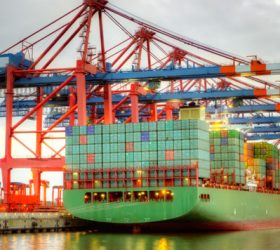Ocean freight or sea freight is the most common form of international transportation preferred by importers and exporters. It accounts for approximately 90% of global freight transportation. Ocean freight is a slightly complicated but economical mode of transportation in which supply-chain management and competitive prices play an important role. Ocean freight is also the most efficient way of transporting heavy goods that occupy large spaces. Airlines often deny such transport due to their size and extremely heavy weight. In addition, ocean freight is also possibly the most environment-friendly way of freight transport as large cargo ships can carry hundreds of gigantic containers in one go.
Ocean freights that carry containers to different locations are usually of four types. The first is ExWorks (EXW) that transports goods to the factory or manufacturer, second is Free On Board (FOB) that transports goods to the internal terminal of the buyer’s country. The third is Delivery At Port (DAP)/Delivery and Duty Unpaid (DDU) that delivers goods directly to the plant or site excluding taxes plus charges and the fourth is Cost Insurance and Freight (CIF) that covers transport to the buyer’s country.
Global Ocean Freight Market Update:
The global ocean freight industry is currently witnessing an imbalance in the demand-supply ratio. This scenario must be analyzed to manage the capacity of the ships for deployment. The supply-demand imbalance is due to certain global trends such as disparity in overcapacity and financial cycles, the adaptation of cargo to container shipping method, a faster-growing port capacity as compared to trade volume, enhanced demand for consumer focus and technology, and sustainability and environmental issues. Talking about the global ocean freight market update, the current global container shipping capacity is growing at a rate of 1.2 percent with the demand estimated to grow at a rate of 3.1 percent.
To keep the freight charges in control, capacity deployment should be managed at the time of delivery of ships. Some alliances and mergers in the recent past are also indicating enhanced shipping capabilities that can result in freight rate recovery.
Global Ocean Freight Business Opportunities:
The global trade market is growing steadily and it is presenting business opportunities that can be seized to attain a sustainable business model. There are some imbalances in the current ocean freight market that are leading to a need for sustainable development in the industry at a global level.
Talking about the trade lane capacity, the Asia-Europe trade lane is expected to face the largest capacity and freight rate pressure with current gross capacity growth of 89 percent. Such growth is driven by the delivery of new ships that are sized above 10,000 TEU. In the Trans-Pacific trade lane, larger ships are going to replace small vessels. The Trans-Pacific region and Latin American region are dominated by ships of 7,500 TEU to 9,999 TEU sizes whereas the Middle East and Indian subcontinent are dominated by the ships of 5,100 TEU – 7,499 TEU size. Such developments are surely creating new business opportunities for enterprises that are willing to invest and reap the benefits of changing industry requirements.
The ocean freight industry has immense relevance despite the advancements in air cargo shipments since ocean freight is the most cost-effective means to transport large quantities of goods. Amidst growing competition, the ocean freight industry needs certain strategic changes to retain market growth. However, the good old shipping container practices are still favored by global importers and exporters due to their specific perks.
